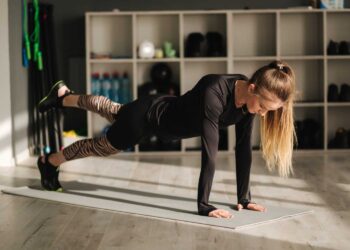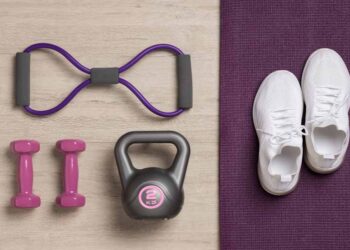Table of Contents
Are you a beginner looking to kickstart your fitness journey with an effective 7-Day Fitness Plan? Imagine improving your strength, flexibility, energy levels, and overall well-being in just one week. It might sound ambitious, but a well-structured 7-Day Fitness Plan tailored to beginners can yield significant results in a short period of time.
Many people believe that achieving noticeable fitness results takes months or even years, but the right 7-Day Fitness Plan combines a balanced mix of cardio, strength training, and flexibility exercises to jumpstart your progress. This plan focuses on targeting different muscle groups, improving endurance, and building a strong foundation for long-term success.
Each day of this 7-Day Fitness Plan includes carefully selected workouts that gradually increase in intensity, allowing your body to adapt and develop without risking injury. From full-body workouts to targeted muscle group exercises, this plan will keep you motivated and engaged throughout the week. You’ll not only experience physical changes but also a boost in your confidence and energy levels, making it easier to continue your fitness journey beyond the first seven days.
So, how does this 7-Day Fitness Plan work, and what exercises should you perform each day? In this article, we’ll guide you step-by-step through the process of creating a personalized workout routine that’s effective, safe, and perfectly suited to your needs. Get ready to transform your life in just one week!
Key Takeaways:
- A weekly exercise plan for beginners can lead to significant improvements in strength, flexibility, energy levels, and overall well-being.
- Contrary to popular belief, visible results can be achieved within just seven days of focused exercise.
- This article will guide you through the process of creating a well-balanced and effective workout routine.
- Consulting with a healthcare provider or fitness professional before starting a new exercise plan is crucial.
- Remember to listen to your body, gradually increase the intensity and duration of your workouts, and prioritize rest and recovery.
01
of 08
Determining Your Exercise Needs for a 7-Day Fitness Plan
One of the first steps in creating a successful 7-Day Fitness Plan is determining how much exercise you need based on your current fitness level and goals. The U.S. Department of Health and Human Services and the World Health Organization recommend that healthy adults aim for 150 to 300 minutes of moderate-intensity aerobic activity or 75 to 150 minutes of vigorous-intensity aerobic activity per week. This guideline can serve as a framework for your 7-Day Fitness Plan, ensuring you get the right amount of activity each day.
In addition to cardio, incorporating strength training exercises at least twice a week is essential for building muscle and improving overall strength. For adults over 65, adding balance exercises is crucial to enhance stability and prevent falls. Each component should be included in your 7-Day Fitness Plan to create a comprehensive routine that targets various aspects of fitness.
If you’re just starting out, it’s recommended to begin with a beginner workout routine that gradually increases in intensity and duration. This approach helps you establish a solid foundation and minimizes the risk of injury. Start with exercises that you enjoy and feel comfortable with, such as brisk walking, light jogging, or simple strength exercises like bodyweight squats and push-ups. Gradually incorporate more challenging exercises into your 7-Day Fitness Plan as your fitness level improves.
Remember, everyone’s exercise needs and fitness goals are unique. It’s important to listen to your body and make adjustments to your exercise routine accordingly.
Additionally, flexibility exercises, such as yoga or dynamic stretching, can be included in your daily routine to enhance range of motion and reduce muscle stiffness. This well-rounded approach in your 7-Day Fitness Plan ensures you cover all bases of fitness—cardiovascular health, muscular strength, and flexibility.
Everyone’s exercise needs and fitness goals are unique, so it’s essential to listen to your body and consult with a healthcare professional or fitness trainer to ensure your 7-Day Fitness Plan aligns with your abilities and aspirations. By taking the time to determine your exercise needs, you can set yourself up for a successful fitness journey that’s safe, effective, and sustainable.
Benefits of a Weekly Beginner Exercise Program in a 7-Day Fitness Plan
Starting a weekly beginner exercise program offers a multitude of benefits. Here are a few key advantages of incorporating a regular exercise routine into your life:
- Improved cardiovascular health and endurance
- Increased muscle strength and tone
- Enhanced flexibility and mobility
- Boosted energy levels and mood
- Weight management and improved body composition
- Reduced risk of chronic diseases, such as heart disease, diabetes, and certain cancers
- Increased bone density and reduced risk of osteoporosis
- Better sleep quality and relaxation
These benefits highlight the importance of maintaining a regular exercise routine, regardless of your fitness level. Whether you’re a beginner or have been exercising for years, finding a workout routine that suits your needs and interests is crucial for long-term health and well-being.
| Exercise Type | Frequency | Duration |
| Cardiovascular exercises | At least 3-5 days per week | 30-60 minutes per session |
| Strength training | 2-3 days per week | 20-30 minutes per session |
| Flexibility exercises | At least 2-3 days per week | 10-15 minutes per session |
Remember, these guidelines are just a starting point. Feel free to adjust the frequency and duration of each exercise type based on your personal preferences and fitness goals.
02
of 08
Designing Your Workout Routine for an Effective 7-Day Fitness Plan
Creating a structured 7-Day Fitness Plan requires balancing various types of exercises that target all aspects of fitness—cardiovascular health, strength, flexibility, and balance. Begin by scheduling specific types of exercises for each day to ensure a comprehensive workout routine. For example, focus on cardiovascular exercises like brisk walking or cycling on some days, while dedicating others to strength training exercises such as squats, lunges, and push-ups.

Cardiovascular Exercise:
Cardio is essential for improving heart health and endurance. Include activities such as walking, running, cycling, or swimming in your 7-Day Fitness Plan. Aim for at least 150 minutes of moderate-intensity or 75 minutes of vigorous-intensity aerobic activity each week. Start with shorter durations and gradually increase the intensity and duration as your fitness level improves. Remember to warm up before and cool down after each cardio session.
Strength Training:
Strength training helps build lean muscle mass, increase metabolism, and improve overall strength. Incorporate exercises like squats, lunges, push-ups, rows, and shoulder presses that target all major muscle groups. Plan for two to three strength training sessions per week, ensuring a day of rest between each session to allow muscles to recover and rebuild. This approach is key to maximizing results in your 7-Day Fitness Plan.
Balance Exercises:
Balance exercises are crucial for maintaining stability and preventing falls, especially as we age. Include exercises such as single-leg stands, heel-to-toe walking, or yoga poses like tree pose or warrior pose in your routine. Practice balance exercises at least two days a week, and gradually increase the difficulty or duration of each exercise over time to continually challenge your balance and coordination.
Flexibility Work:
Flexibility exercises, such as stretching or activities like yoga or Pilates, enhance joint mobility and muscle flexibility. Include flexibility sessions two to three days a week, focusing on major muscle groups. Perform stretches when your muscles are warm, such as after a workout or following a light warm-up routine, to prevent injuries and increase range of motion.
Rest and Recovery:
Rest days are just as important as active workout days in a 7-Day Fitness Plan. They allow your body to recover, repair, and grow stronger. On rest days, engage in low-intensity activities like walking, leisurely cycling, or gentle stretching. Listen to your body and take additional rest days as needed, especially if you feel fatigued or experience muscle soreness.
By incorporating these elements into your 7-Day Fitness Plan, you’ll create a well-rounded workout routine that enhances strength, flexibility, and cardiovascular health, while also allowing for proper recovery and balance training. This approach will help you achieve a comprehensive fitness level, making your exercise plan more effective and sustainable over time.
03
of 08
Sample 7-Day Fitness Plan Schedule for Beginners
To help you get started on your fitness journey, here’s a sample 7-day workout plan that incorporates a variety of exercises. This routine can be adjusted to suit your preferences and fitness level. Remember to listen to your body and make any necessary adjustments as needed. Begin each workout with a proper warm-up and end with a cool-down. Gradually increase the intensity and duration of your workouts over time to challenge your body and achieve optimal results.
Day 1: Cardiovascular Exercise
Begin your week with a cardio workout to get your heart rate up and improve your endurance. Choose an activity you enjoy, such as running, cycling, or swimming. Aim for a 30-minute session of moderate-intensity exercise.
Day 2: Strength Training
Focus on building strength on day two. Incorporate exercises for major muscle groups, including squats, lunges, push-ups, and dumbbell rows. Perform 2-3 sets of 10-12 repetitions for each exercise.
Day 3: Active Rest
Give your body a chance to recover and rejuvenate by engaging in active rest. This can include activities such as yoga, Pilates, or light stretching. Enjoy a low-impact workout to increase blood flow and improve flexibility.
Day 4: Flexibility and Balance
On day four, focus on improving flexibility and balance. Incorporate exercises such as yoga poses, static stretches, and balance drills. Spend at least 20 minutes on these exercises to enhance your range of motion and stability.
Day 5: Full-Body Workout
Engage your entire body on day five with a full-body workout. Combine strength exercises with cardiovascular movements to challenge your muscles and increase your heart rate. Incorporate exercises like burpees, mountain climbers, squats, and bicep curls. Perform 2-3 sets of 10-12 repetitions for each exercise.
Day 6: HIIT Workout
Intensify your workout on day six with a high-intensity interval training (HIIT) session. Alternate between periods of intense exercise, such as sprints or jumping jacks, and rest or low-intensity exercises, like walking or jogging. Aim for 20-30 minutes of HIIT training.
Day 7: Rest and Recovery
On the final day of the week, prioritize rest and recovery. Give your body time to heal and repair by engaging in gentle activities such as walking or stretching. Allow yourself to relax and recharge for the upcoming week.
Workout Routine Example
Here’s an example of a simple weekly exercise routine that incorporates different types of workouts:
| Day | Activity |
|---|---|
| Monday | Cardio: 30 minutes of brisk walking |
| Tuesday | Strength Training: Full-body workout with bodyweight exercises |
| Wednesday | Rest Day: Gentle stretching or light yoga |
| Thursday | Cardio: 20 minutes of cycling + Balance Exercises: 10 minutes of balance drills |
| Friday | Strength Training: Upper body workout using dumbbells or resistance bands |
| Saturday | Flexibility Work: 20 minutes of dedicated stretching or yoga |
| Sunday | Rest Day: Light activity such as leisurely walking or gardening |
Remember, this sample 7-day fitness schedule is just a starting point. Feel free to customize it based on your preferences, schedule, and fitness goals. As you progress, challenge yourself by increasing the intensity or duration of your workouts. Stay consistent, listen to your body, and enjoy the rewards of your efforts!
04
of 08
Tips for Effective Strength Training in a 7-Day Fitness Plan
Strength training is a core component of any comprehensive 7-Day Fitness Plan. It not only helps build muscle mass and increase strength but also boosts metabolism, enhances bone density, and improves overall functionality. To make the most of your strength training sessions, it’s essential to understand proper techniques, select the right exercises, and structure your routine for optimal results.

1. Focus on Proper Form and Technique:
Maintaining correct form is crucial in any 7-Day Fitness Plan to prevent injuries and ensure that you’re targeting the right muscles. Poor form can lead to muscle imbalances and strain, hindering your progress. Start with lighter weights, master the movement patterns, and gradually increase the load as you build strength. This approach not only supports safe training but also promotes better engagement of the muscles.
2. Choose the Right Weight and Repetition Range:
For beginners in a 7-Day Fitness Plan, aim for two to four sets of 8 to 25 repetitions per exercise. This repetition range provides a balance between building muscle strength and endurance. If your goal is to build strength, use heavier weights with lower repetitions (e.g., 8-12 reps). For muscle endurance or toning, opt for lighter weights with higher repetitions (e.g., 15-25 reps). Adjust the weight to ensure that the last few reps of each set are challenging yet maintainable with proper form.
3. Organize Your Strength Training Sessions:
To ensure that you’re effectively working all major muscle groups, split your 7-Day Fitness Plan into focused days, such as upper body, lower body, and core. For example:
- Day 1: Upper Body (e.g., chest, shoulders, back, arms)
- Day 3: Lower Body (e.g., quads, hamstrings, glutes, calves)
- Day 5: Core and Stability (e.g., abdominals, obliques, lower back)
This approach gives each muscle group adequate time to rest and recover, while still allowing for frequent training throughout the week.
4. Incorporate Different Types of Sets for Variety:
Mix up your strength training routine with different set types, such as:
- Traditional Sets: Perform a specific number of repetitions for each exercise and then rest before the next set.
- Supersets: Perform two exercises back-to-back without rest, targeting the same or opposing muscle groups (e.g., bicep curls followed by triceps dips).
- Drop Sets: Perform a set to failure, then reduce the weight and continue with additional repetitions to further fatigue the muscles.
Adding variety to your sets helps prevent plateaus and keeps your muscles challenged, which is essential for progress in your 7-Day Fitness Plan.
5. Prioritize Recovery and Rest Days:
Allowing time for recovery is just as crucial as the workouts themselves. Your 7-Day Fitness Plan should include at least one or two active rest days, where you engage in low-intensity activities like walking, yoga, or stretching. This helps reduce muscle soreness, prevents burnout, and promotes overall fitness safety. Listen to your body and adjust your training intensity based on how you feel, taking additional rest days if needed.
| Day | Muscle Group | Exercises |
|---|---|---|
| Monday | Upper Body | Push-ups, Overhead Press, Bent-Over Rows |
| Wednesday | Lower Body | Squats, Lunges, Deadlifts |
| Friday | Core | Plank, Russian Twists, Bicycle Crunches |
By implementing these tips and strategies, you’ll optimize your strength training sessions and ensure that your 7-Day Fitness Plan delivers comprehensive results, helping you build strength, increase muscle mass, and enhance your overall fitness journey.
05
of 08
Benefits and Considerations of High-Intensity Interval Training (HIIT)
High-Intensity Interval Training (HIIT) workouts are a popular choice for individuals following a 7-day fitness plan or beginner fitness schedule. These workouts offer several benefits and considerations to keep in mind. By alternating between short bursts of intense activity and periods of low-intensity exercise or rest, HIIT workouts provide a time-efficient and effective way to improve cardiovascular fitness and metabolic health.

One of the key benefits of HIIT is its ability to maximize calorie burn in a shorter amount of time. The intense bursts of activity during HIIT sessions elevate your heart rate and boost your metabolism, allowing you to burn calories even after your workout is complete. This makes HIIT workouts an excellent choice for those looking to optimize their weight loss efforts within a busy schedule.
Additionally, HIIT workouts can help improve cardiovascular endurance. The intense nature of HIIT sessions challenges your heart and lungs, increasing your aerobic capacity over time. This can lead to improved performance in other physical activities, such as running, cycling, or swimming.
When incorporating HIIT into your 7-day fitness plan or beginner fitness schedule, it’s important to consider a few factors. Firstly, gradually increase the frequency and duration of HIIT workouts to prevent joint pain and overexertion. HIIT can be demanding on your body, so it’s crucial to allow for proper recovery and avoid pushing yourself too hard, especially in the beginning.
It’s also recommended to alternate HIIT workouts with steady-state exercises performed at a sustained, moderate effort. This balance helps prevent burnout and reduces the risk of potential injuries. Including a variety of workout intensities in your overall routine ensures a well-rounded approach to fitness.
To better illustrate the benefits and considerations of HIIT, here’s a table comparing HIIT workouts to steady-state exercises:
| HIIT Workouts | Steady-State Exercises |
|---|---|
| Involves short bursts of intense activity | Performed at a sustained, moderate effort |
| Increases cardiovascular fitness | Improves endurance |
| Time-efficient | Requires longer workout durations |
| Promotes calorie burn even after the workout | Less impact on metabolism post-workout |
| Can be challenging for beginners | More accessible to individuals at various fitness levels |
Keep in mind that individual preferences and fitness goals may influence the choice between HIIT and steady-state exercises. It’s essential to listen to your body and find the right balance that works for you.
Including High-Intensity Interval Training (HIIT) in your 7-day fitness plan or beginner fitness schedule offers numerous benefits. From increased calorie burn to improved cardiovascular fitness, HIIT can be an effective addition to your routine. However, it’s important to practice caution, gradually increase workout intensity, and alternate HIIT with steady-state exercises to maintain a balanced approach. As you progress on your fitness journey, remember to adapt and customize your workouts to align with your individual needs and goals.
06
of 08
The Importance of Active Rest and Recovery in a 7-Day Fitness Plan
Rest and recovery are not just about taking a day off—they play a vital role in optimizing your 7-Day Fitness Plan. After engaging in intense workouts, your muscles experience tiny tears that need time to repair and rebuild. This healing process is what makes muscles stronger and more resilient. Without adequate rest, you risk overtraining, which can lead to muscle fatigue, decreased performance, and potential injuries.
Active rest days are an excellent way to promote recovery without remaining completely sedentary. Incorporating low-intensity activities like walking, light stretching, or yoga helps maintain movement, stimulate blood flow, and alleviate muscle tightness. This gentle activity keeps your muscles engaged without placing excessive strain on them, ensuring that you maintain flexibility and mobility.
During active rest, focus on exercises that promote relaxation and circulation. For instance, yoga can be particularly beneficial as it combines gentle stretching with controlled breathing, which helps relax both your muscles and mind. Engaging in dynamic stretches or foam rolling can also aid in releasing muscle tension and enhancing overall flexibility.
Another important aspect of active rest is maintaining proper hydration and nutrition. Consuming adequate protein and healthy carbohydrates on rest days supports muscle repair and replenishes energy stores, making sure your body is well-prepared for the next workout.
Overlooking rest and recovery can lead to burnout, fatigue, and diminished results. On the other hand, embracing these recovery strategies allows your body to rebuild stronger, leaving you energized and ready to tackle the next session in your 7-Day Fitness Plan with improved performance and reduced risk of injury.
By finding the right balance between active rest and intense training, you ensure a more effective and sustainable fitness journey. Prioritizing rest isn’t a sign of weakness; it’s an intelligent approach that enhances your overall progress, helping you achieve long-term fitness success.
Benefits of Active Rest and Recovery:
- Prevents injuries caused by overtraining
- Reduces muscle soreness and fatigue
- Improves overall performance
- Allows time for muscles to repair and grow stronger
- Helps maintain motivation and prevent burnout
Make sure to schedule regular rest days into your weekly workout plan. These days of active rest will not only benefit your physical well-being but also contribute to a more sustainable and enjoyable fitness journey.
07
of 08
Conclusion
Incorporating a 7-Day Fitness Plan is a powerful way for beginners to kickstart their fitness journey. By following a well-designed routine that includes cardio, strength training, balance exercises, flexibility work, and rest days, you can experience significant improvements in your overall health and well-being. It’s important to start with an appropriate level of intensity and gradually increase the duration and difficulty of your workouts as your fitness improves. Consistency is key, so make sure to stay dedicated to your beginner 7-Day Fitness Plan routine and listen to your body.
Remember that everyone’s fitness journey is unique, so feel free to tailor your routine to meet your individual needs and preferences. Don’t forget to have fun along the way! Engaging in regular exercise not only benefits your physical health but also has positive effects on your mental well-being and quality of life. So, whether you’re just starting your fitness journey or looking to switch up your current routine, a 7-Day Fitness Plan can be the perfect way to achieve your goals and transform your life.
Start today and embark on a path towards a healthier, stronger self, and enjoy the amazing benefits that a regular exercise routine can bring. Wishing you success and satisfaction as you embark on your fitness journey!













